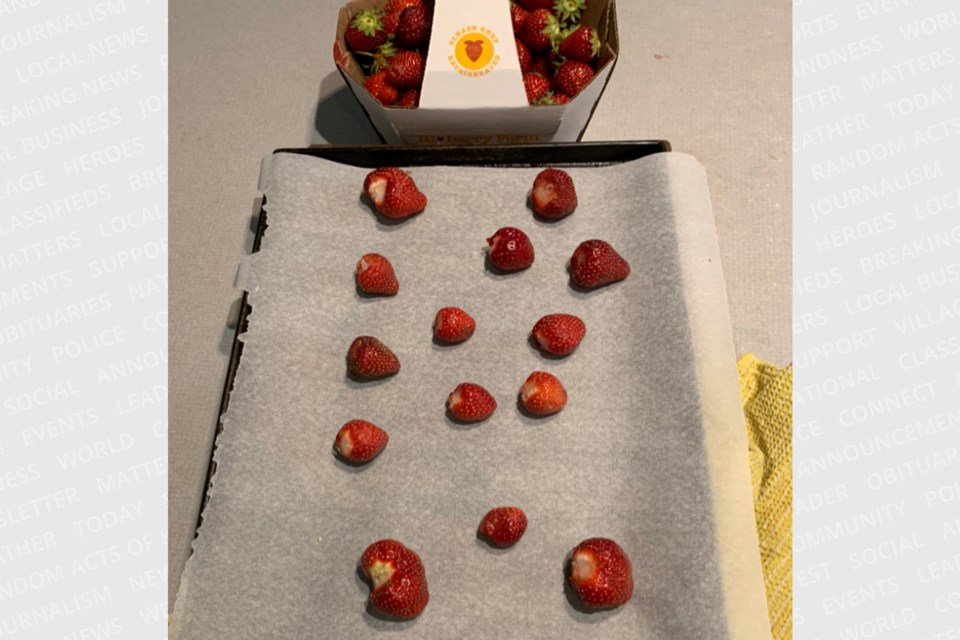July is the time for eating delicious, sweet, freshly-picked strawberries. Your farmers’ market or road-side stand are loaded with aromatic, little red jewels just waiting to be slathered in whipped cream.
Imagine if this juicy perfection was available in early January. Preserving the sweetness of the harvest by canning fruit into jellies and jams may be the best known way but the freezer offers us a wonderful alternative. Freezing strawberries and other summer produce can be done with less processing, plenty of nutrition and that beautiful flavour of summer.
Freezing your own produce helps save money on food. The variety of frozen fruits and vegetables in the grocery store has increased alongside the popularity of smoothies. Now you can buy frozen mango, avocado and mixtures of fruits or veggies.
Compared to these frozen products in the grocery store you can save about $1 per bag by picking and freezing your own strawberries. Buying your summer produce in bulk can reduce the costs even more. It’s common to find bushels of tomatoes and red peppers and more at summer markets.
Frozen produce is nutritious food. Frozen fruits and vegetables retain a lot of their nutrition because they can be picked at peak ripeness and frozen
immediately.
Freezing fruits and vegetables at home is a fast and convenient way to preserve them for future use.
In the past fruits and vegetables were packed into syrups or sugar before being frozen. When freezing produce at home most people want to freeze the food without the added sugar.
The best practice is to wash your produce, allow it to dry and place it on a sheet pan to be frozen. The frozen food can then be transferred to a sealed container or a bag with the air removed. Some vegetables are better blanched (boiled in water for one minute and then put in an ice-bath to cool) and then frozen.
Most fruits and vegetables will last for several months and up to one year in the freezer. For more information, check out the David Suzuki foundation website for tips on how to freeze various fruits and vegetables.
There are plenty of ways to include nutritious and budget-friendly frozen produce in your meals. Smoothies are a great way to use up frozen fruit and vegetables. Pack a freezer bag with your favourite smoothie ingredients like banana, peanut butter and strawberries. You’ll be all ready to just add yogurt and milk to blend up a quick morning meal.
Adding frozen fruit to baking is delicious. Picture blueberry muffins or cherry scones on a cold day in February. Frozen fruit salad, just a mixture of frozen fruits combined with yogurt and honey, is also a popular favourite. Squash soup can be made with frozen squash cubes. Using frozen green beans in a casserole is both common and delicious.
Social media offers us more ideas for putting the freezer to use including freezing your extra herbs in ice cube trays and making freezer jam instead of canning your jam.
My favourite idea is from a local baker who saves her plastic milk bags and repacks them with her hand-picked frozen blueberries in just the right volume for a delicious blueberry dessert come winter.
While Guelph is not yet home to a community freezer, this trend is becoming more common as a way to share food in the community.
If you’re going strawberry picking or picking up a basket of green beans in the coming days consider sharing the bounty of the season with other folks in Guelph.
For instance, Food Equity with Dignity or FEWD is making great use of some beautiful homegrown, hand-picked strawberries donated by a local citizen. FEWD is a mobile food security initiative that centres dignity, quality and accessibility while diverting high quality foodstuffs from landfill.
Check them out at FEWD.ca and you can help ensure that everybody eats!



